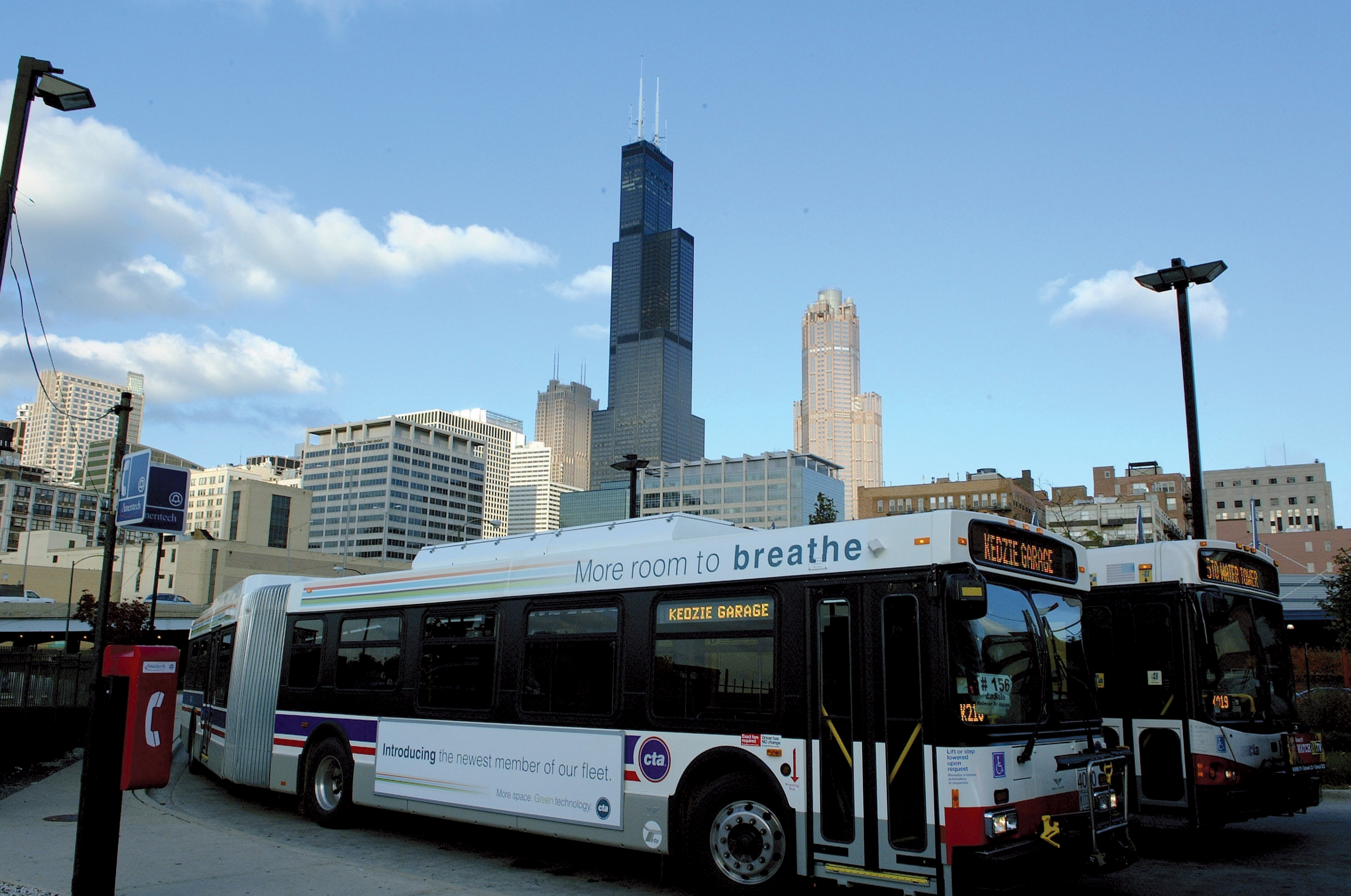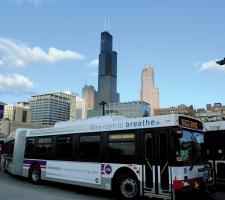
All Chicago buses are now equipped with Bus Tracker
Chicago pioneers new passenger information initiatives. By David Crawford
The US'sThe local store digital display bus information service - a first for the US outside major terminals and interchanges - is being trialled in the Wicker Park neighbourhood, a recently gentrified area attractive to white-collar workers in the central business district. In 2005, Chicago City Council designated it a Special Service Area (SSA - known as a business or community improvement district in other cities), giving it local taxing powers to fund enhancements.
The pilot centres on an area near the intersection of three busy avenues served by several CTA bus routes as well as a station on the Blue Line of the 'L' metro network.
The Wicker Park/Bucktown (WPD) Chamber of Commerce has supported it by using SSA funds to buy 17in monitor screens supplied by Indiana-based
The Wicker Park screens continuously display Bus Tracker-derived next arrival times along their bottom portion (on a green background familiar from the CTA website), while neighbourhood alerts and local news items and events rotate above. The latter service has become attractive following the 2009 closure of both of the area's community newspapers.
Free to view
An initial 11 local businesses (including the Chamber) have taken the system. They pay nothing for it, but sign an agreement to host a display for one year, provide an outlet and internet connection, and allow people to view it without requiring them to make a purchase.Says Chamber programme manager Jamie Simone: "The RedPost sign system and Bus Tracker seemed a natural pairing. Local businesses like the extra sales being generated by increased foot traffic from passengers seeking travel information.
"All the displays face inwards so people are forced into the stores to see the CTA advice. Our goal is to improve the availability of transit information to the public and so alleviate traffic congestion and parking pressures." One aim of the pilot is to extend access to Bus Tracker data for people on the move more widely than via, for example, mobile devices; in the face of budget-driven service cuts, the CTA is naturally supportive of any moves that help to make continuing bus usage attractive and convenient.
The Chamber plans an early start on statistical analysis of the project. Meanwhile, it is working with the CTA to extend the concept to further organisations, including the city's four universities and public housing schemes. The Massachusetts Transit Authority is among public transport agencies that have paid inspection visits.
Developer tools
The Wicker Park pilot has served as a practical forerunner for the CTA's newly launched developers' tools programme, which now has its own web page at www.transitchicago.com. It is designed to encourage commercial or public organisations in Chicago to access and download Bus Tracker and other transit data to create their own desktop or mobile applications and widgets.They can then offer these to their customers or audiences to help improve their travel planning. Static information, such as schedules and general service information, is available as a downloadable package in an open format.
Real-time service information and customer alert data is also available through dedicated Application Programming Interfaces (APIs), which will allow third-party applications to request up-to-the-minute information from CTA Bus Tracker and service information published on transitchicago.com. Current data offerings via the CTA Devedloper Center are: Bus Tracker API (up-to-the-minute arrival predictions and location data for buses in operation, as well as re-routing information); Customer Alerts API (status and detailed information about planned and unplanned events impacting CTA bus and rail services);
The Chicago Transit Authority
The CTA operates the US's second-largest public transportation system, a regional network that serves the City of Chicago and 40 suburban communities. Average weekday ridership is 1.68 million (1.04 million by bus and 0.64 million by rail).
It runs 1,970 buses on 150 routes, covering 4,050 route kilometres (2,470 miles). The 'L' network has eight rapid transit routes covering 390 route kilometres (240 miles).The Bus Tracker API is designed to allow developers to request and retrieve data directly from the BusTime system, developed by New York-based
Developers can make HTTP requests for the data and receive XML responses to build their applications. The CTA takes the precaution of warning developers to be aware - so that they can alert their users as appropriate - that arrival times are estimates subject to extraneous influences; and that Bus Tracker will stop showing vehicles that depart from their regular routes, or if hardware or communications problems prevent them from reporting in.
Bandwidth management
A developer will receive a CTA Bus Tracker account key which will be included in each data request. By default, one API key can make a maximum of 10,000 requests per day, to help the CTA with bandwidth management.Developers expecting a higher usage rate have to request the raising of their cap, and the CTA will evaluate these requests on a case-by-case basis. The API is designed to be backward-compatible, allowing time for developers to upgrade their applications to make use of new features.
The Customer Alerts API updates on planned and unplanned events are ranked on their severity levels of impact on services on a scale from 1-99 and linked to affected routes and stops. The CTA stresses that the data is entered, manually, by experienced control centre staff for credibility.
Developers do not have to pay to access the information. The response, the CTA's Catherine Hosinski told ITS International, "has been very positive".
Bus Tracker
Both initiatives reflect the CTA's policy of making Bus Tracker data more widely accessible without itself having to shoulder the cost. "Sharing our investment in technology will help create innovative tools more quickly and in a broader range than the agency will be able to provide on its own," says CTA president Richard Rodriguez.The CTA started installing the US$24.1 million Bus Tracker system in 2007 (major suppliers alongside Clever Devices are
Bunching averaged 3.9 per cent in 2007. Over the first three quarters of 2009, however, the figure fell to 2.3 per cent (representing a 40 per cent drop) according to an internal report produced in November 2009.
From a passenger perspective, 'CTA Bus Tracker' was the second most-Googled item by Chicagoans in 2009. Recent data shows nearly 50,000 visits on an average weekday, with over 10,000 emails sent to the 5,200-plus passengers registered to receive Bus Tracker alerts.
The CTA is the largest provider of real-time bus service information in the US. Other transit agencies such as the San Francisco Municipal Transit Agency (MUNI) and Boston's MBTA have now followed suit.
In December 2009, the authority introduced a text messaging service giving the next two arrivals at given stops, based on stop ID numbers that are available via the Internet. Early in 2010, it began piloting a programme in which stop ID numbers and texting instructions are posted on stops at an initial 42 locations in the city.
Traffic information sharing
The CTA is now sharing its real-time Bus Tracker data with the Chicago Department of Transportation (CDOT) and the city'sWith buses acting as probes, the city agencies are able to monitor current conditions on strategic arterials, in support of new traffic management and traveller information initiatives. These range from more responsive signal planning to major event and incident or emergency management.
The information will be made available to the public in real time to help travel decision-making, while emergency responders will be able to use it for more effective dispatch and routing. Following pilot evaluation, the agencies hope to move forward with a prototype deployment over the next 12-18 months.






